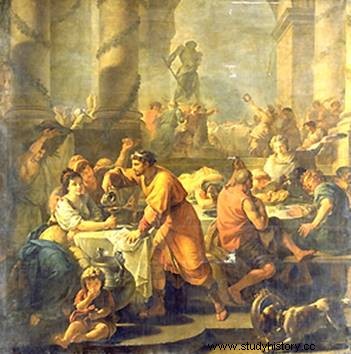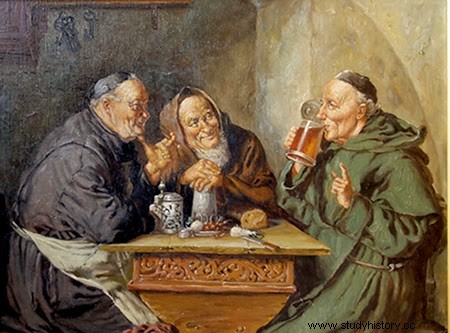After the disappearance of the Western Roman Empire at the hands of the barbarians, its inhabitants maintained Roman customs while incorporating other new arrivals with the peoples who settled in the old imperial domains. These changes were reflected on the tables, where Roman wine and beer from the north will complement each other to satisfy the inhabitants of the Middle Ages. There was no competition, they were different markets:to the north of the Alps they drank beer and to the south wine.

In the north, beer was the drink of rough warriors to celebrate triumph and prosperity and, moreover, a "food". There are documents from the 14th century in which it is recommended to include a mug of beer or a bowl of soup at breakfast, even for children. The main ingredients of this beer soup were the beer itself, eggs and bread, and its preparation…
A shell with beer is put on the fire and butter is added when it is already hot. Once the butter has melted, remove it from the heat and mix it with a couple of beaten eggs. The mixture is stirred vigorously and a pinch of salt is added. On the plate where it is going to be served, place a slice of white bread and pour the beer mixture over the bread.
In 18th century England, ale soup was a familiar dish and up to three liters of ale soup were consumed daily. In the Nordic regions the two staple foods were bread and beer, in that order. In fact, the German physician Johann Placotomus wrote:
[…] people of both sexes and all ages, the healthy and the sick alike require it (beer).
Frederick the Great , the German emperor who ruled Prussia between 1740 and 1786, was a great promoter of beer. In 1777 he proclaims the defense of beer against coffee:
It is disgusting to note the increase in the amount of coffee used by my subjects and the amount of money leaving the country in imports. Everyone is using coffee. My people have to drink beer. His Majesty was bred on beer and so were his ancestors and his officers. Many battles have been fought and won by the beer-fed soldiers, and the king does not believe that the coffee-drinking soldiers will be able to endure hardships or beat their enemies in the event of a new war.
But why has beer consumption become so popular? For that we must forget water as a good as we know it today:it was not within reach and potability was a matter of luck. In fact, it was safer and more reliable to drink a beverage like beer than water itself. The barley fermentation process destroys most of the harmful bacteria and other germs that can contaminate the water. So beer was a much healthier drink than water.

Brewer
Like almost everything in the Middle Ages, the Church had an absolute monopoly on the beer trade and kept its recipe secret until the 11th century. The first beer brewed by the monks was cervesia monacorum that they made with water, barley, yeast and gruyt or gruut (a mixture of myrtle, forest fruits and wild rosemary that gave it a spicy flavor). Nobody knew what to do with those ingredients, only the monks.
The Abbey of Sankt-Gallen , in present-day Switzerland, was one of the first abbeys to sell beer. There is evidence that in the 10th century it sold three types of beers:
- first cousin :with a pleasant taste, it was reserved for the high ecclesiastical hierarchies and the nobles who went to the abbey
- the second :the same as the previous one but with less graduation. The monks drank it
- the party :the smoothest of all and with fewer ingredients than the prima melior. Destined for the consumption of the poor and pilgrims

But the Church ran out of its “bargain” with the hop war. With the growth of cities, and the ease of transporting and buying goods from all over Europe, hops came for brewing with the sole aim of wresting the monopoly away from the monks and their gruyt . Hops were used long before but as a medicinal herb that was characterized by its good flavor; They called it “the medicine that tastes good ”. The fatal blow to the monks' beer monopoly was dealt by the support of the civil power for the production of beer with hops... the monks did not pay taxes and the brewing with hops of the brewers was taxed> . At the end of the 12th century, the urban explosion gave full control of the brewing industry to artisans and civil authorities fixed the composition of beer as it is consumed today:barley malt, water, hops and yeast.
The beer we know with its bitter taste is born from hops. From Celtic hops, they derive the beer English, the bière French, the bier German and the beer Italian. In Spain, the bitter drink with hops did not arrive until Carlos V opened the first brewery in Spain in the Monastery of Yuste (Cáceres). In England it was not until the 15th century that beer with hops (beer) began to be brewed. ) versus non-hop brewed (ale ). It is said that the maceration process was invented by Jean Primus , Juan I the Duke of Barbante, during a party. In fact, Gambrinus , the unofficial pattern of the brewers, is derived from Jean Primu
Collaboration:Edmundo Pérez
Source:Beer in the Middle Ages and the Renaissance – Richard W. Unger
